| |
| |
Caption: Book - History of the University (Nevins)
This is a reduced-resolution page image for fast online browsing.

EXTRACTED TEXT FROM PAGE:
52 BEGINNINGS OF THE UNIVERSITY The majority of the buildings were of the cheaper grades of lumber, scarcely a half dozen in the two towns being of brick. Stock of all kinds ran at large in the streets, as in the country near by, and the residences had to be securely, fenced against its inroads. The public ways were littered with woodpiles and unused wagons. There was no general water system, and outbreaks of typhoid were frequent. Five or six churches served the two towns, and two small schoolhouses. All the territory to the east, south, and west of the University grounds was unoccupied by buildings, and most of it was virgin soil; while to the north ran only a sparse line of houses connecting the Twin Cities. Between the two was a single street railway line, provided with a single car, which at intervals of two hours was hauled bumping by a team of mules across the mile-and-a-half stretch—the fare ten cents and the passengers few. The building in which the University was to be housed was afive-storystructure, with a four-story addition to the south, was 125 feet in length, and stood commandingly on the bare prairie, high above everything in the towns. The entrance faced the north, near the line now marked by Clark Street, while a side door opened on Wright Street. It had as yet been roughly finished, these doors opening directly upon tne ground level, and a Trustee remarked that it looked like a stake driven into the ground. Entering, the visitor was confronted by an ugly staircase that wound up from story to story. The main portion contained recitation and dormitory rooms; while in the wing were more recitation rooms, a refectory, and on the upper floor a chapel. No bushes or trees stood near; debris was scattered about; the only paths were the trespassing tracks of teamsters. The immediate campus comprised ten
| |